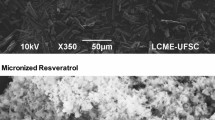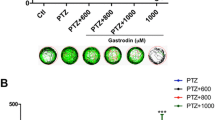Abstract
Epilepsy affects around 50 million people worldwide, and an important number of patients (30%) fail to respond to any available antiepileptic drug. Previous studies have shown that luteolin presents a promising potential as an anticonvulsant. On the other hand, different studies showed that luteolin does not promote anticonvulsant effects. Therefore, there is a lack of consensus about the use of luteolin for seizure control. Luteolin low bioavailability could be a limiting factor to obtain better results. Attractively, micronization technology has been applied to improve flavonoids bioavailability. Thus, the present study aimed to investigate the effects of luteolin on its raw form and micronized luteolin in a PTZ-induced seizure model in adult zebrafish (Danio rerio). Our results demonstrate that luteolin and micronized luteolin did not block PTZ-induced seizures in adult zebrafish. Also, luteolin and micronized luteolin did not provoke behavioral changes. Finally, our results show that 24 h after seizure occurrence, no changes were detected for p70S6Kb, interleukin 1β, and caspase-3 transcript levels. Altogether, we failed to observe an anticonvulsant potential of luteolin in adult zebrafish, even in its micronized form. However, we recommend new studies to investigate luteolin benefits in epilepsy.





Similar content being viewed by others
Data Availability
The datasets generated during and/or analyzed during the current study are available from the corresponding author on reasonable request.
References
Devinsky O, Vezzani A, O’Brien TJ et al (2018) Epilepsy. Nat Rev Dis Primers. https://doi.org/10.1038/nrdp.2018.24
Fisher RS, Acevedo C, Arzimanoglou A et al (2014) ILAE official report: a practical clinical definition of epilepsy. Epilepsia 55:475–482. https://doi.org/10.1111/epi.12550
Berg AT (2006) Defining intractable epilepsy. Adv Neurol 97:5–10
Witt J-A, Elger CE, Helmstaedter C (2013) Which drug-induced side effects would be tolerated in the prospect of seizure control? Epilepsy Behav 29:141–143. https://doi.org/10.1016/j.yebeh.2013.07.013
Tambe R, Patil A, Jain P et al (2017) Assessment of luteolin isolated from Eclipta alba leaves in animal models of epilepsy. Pharm Biol 55:264–268. https://doi.org/10.1080/13880209.2016.1260597
Shaikh MF, Tan KN, Borges K (2013) Anticonvulsant screening of luteolin in four mouse seizure models. Neurosci Lett 550:195–199. https://doi.org/10.1016/j.neulet.2013.06.065
Almeida ER, Lima-Rezende CA, Schneider SE et al (2021) Micronized resveratrol shows anticonvulsant properties in pentylenetetrazole-induced seizure model in adult zebrafish. Neurochem Res 46:241–251. https://doi.org/10.1007/s11064-020-03158-0
Decui L, Garbinato CLL, Schneider SE et al (2020) Micronized resveratrol shows promising effects in a seizure model in zebrafish and signalizes an important advance in epilepsy treatment. Epilepsy Res 159:106243. https://doi.org/10.1016/j.eplepsyres.2019.106243
Bertoncello KT, Aguiar GPS, Oliveira JV, Siebel AM (2018) Micronization potentiates curcumin’s anti-seizure effect and brings an important advance in epilepsy treatment. Sci Rep. https://doi.org/10.1038/s41598-018-20897-x
Cottart C-H, Nivet-Antoine V, Laguillier-Morizot C, Beaudeux J-L (2010) Resveratrol bioavailability and toxicity in humans. Mol Nutr Food Res 54:7–16. https://doi.org/10.1002/mnfr.200900437
Aguiar GPS, Arcari BD, Chaves LMPC et al (2018) Micronization of trans-resveratrol by supercritical fluid: dissolution, solubility and in vitro antioxidant activity. Ind Crops Prod 112:1–5. https://doi.org/10.1016/j.indcrop.2017.11.008
Kurniawansyah F, Quachie L, Mammucari R, Foster NR (2017) Improving the dissolution properties of curcumin using dense gas antisolvent technology. Int J Pharm 521:239–248. https://doi.org/10.1016/j.ijpharm.2017.02.018
Pessoa AS, Aguiar GPS, Vladimir Oliveira J et al (2019) Precipitation of resveratrol-isoniazid and resveratrol-nicotinamide cocrystals by gas antisolvent. J Supercrit Fluids 145:93–102. https://doi.org/10.1016/j.supflu.2018.11.014
Ribas MM, Aguiar GPS, Muller LG et al (2019) Curcumin-nicotinamide cocrystallization with supercritical solvent (CSS): synthesis, characterization and in vivo antinociceptive and anti-inflammatory activities. Ind Crops Prod 139:111537. https://doi.org/10.1016/j.indcrop.2019.111537
Bevilaqua F, Sachett A, Chitolina R et al (2020) A mixture of fipronil and fungicides induces alterations on behavioral and oxidative stress parameters in zebrafish. Ecotoxicology 29:140–147. https://doi.org/10.1007/s10646-019-02146-7
Ministério da Ciência (2018) Tecnologia e Inovação Conselho Nacional de Controle de experimentação animal. Diretrizes da prática de eutanásia do CONCEA. Brasília, DF. Anexo. p. 98. https://www.mctic.gov.br/mctic/export/sites/institucional/legislacao/Arquivos/Anexo_Res_ Norm ativa_Concea_37_2018. Accessed 24 July 2021
Baraban SC, Taylor MR, Castro PA, Baier H (2005) Pentylenetetrazole induced changes in zebrafish behavior, neural activity and c-fos expression. Neuroscience 131:759–768. https://doi.org/10.1016/j.neuroscience.2004.11.031
Livak KJ, Schmittgen TD (2001) Analysis of relative gene expression data using real-time quantitative PCR and the 2−ΔΔCT method. Methods 25:402–408. https://doi.org/10.1006/meth.2001.1262
Tang R, Dodd A, Lai D et al (2007) Validation of zebrafish (Danio rerio) reference genes for quantitative real-time RT-PCR normalization. Acta Biochim Biophys Sin 39:384–390. https://doi.org/10.1111/j.1745-7270.2007.00283.x
Mei J, Zhang Q-Y, Li Z et al (2008) C1q-like inhibits p53-mediated apoptosis and controls normal hematopoiesis during zebrafish embryogenesis. Dev Biol 319:273–284. https://doi.org/10.1016/j.ydbio.2008.04.022
van der Vaart M, Svoboda O, Weijts BG et al (2017) Mecp2 regulates tnfa during zebrafish embryonic development and acute inflammation. Dis Model Mech 10:1439–1451. https://doi.org/10.1242/dmm.026922
Frank DF, Miller GW, Connon RE et al (2017) Transcriptomic profiling of mTOR and ryanodine receptor signaling molecules in developing zebrafish in the absence and presence of PCB 95. PeerJ 5:e4106. https://doi.org/10.7717/peerj.4106
Hammer Ø, Harper DA, Ryan PD (2001) Past: paleontological statistics software package for education and data analysis. Palaeontol Electron 4(1):9
Rice WR (1989) Analyzing tables of statistical tests. Evolution 43:223. https://doi.org/10.2307/2409177
Weissgerber TL, Milic NM, Winham SJ, Garovic VD (2015) Beyond bar and line graphs: time for a new data presentation paradigm. PLoS Biol 13:e1002128. https://doi.org/10.1371/journal.pbio.1002128
Giron D (1995) Thermal analysis and calorimetric methods in the characterisation of polymorphs and solvates. Thermochim Acta 248:1–59. https://doi.org/10.1016/0040-6031(94)01953-E
Brittain HG (2012) Polymorphism and solvatomorphism 2010. J Pharm Sci 101:2271–2280. https://doi.org/10.1002/jps
Cheng Y, Xu W, Chen Z et al (2016) Micronization of etoposide using solution-enhanced dispersion by supercritical CO2. J Supercrit Fluids 115:10–16. https://doi.org/10.1016/j.supflu.2016.03.006
Di Capua A, Adami R, Reverchon E (2017) Production of luteolin/biopolymer microspheres by supercritical assisted atomization. Ind Eng Chem Res 56:4334–4340. https://doi.org/10.1021/acs.iecr.7b00211
Di CA, Adami R, Izzo L, Reverchon E (2017) Luteolin / dextran-FITC fluorescent microspheres produced by supercritical assisted atomization. J Supercrit Fluids 130:97–104. https://doi.org/10.1016/j.supflu.2017.07.034
Coleta M, Campos MG, Cotrim MD et al (2008) Assessment of luteolin (3′,4′,5,7-tetrahydroxyflavone) neuropharmacological activity. Behav Brain Res 189:75–82. https://doi.org/10.1016/j.bbr.2007.12.010
Xu B, Li X-X, He G-R et al (2010) Luteolin promotes long-term potentiation and improves cognitive functions in chronic cerebral hypoperfused rats. Eur J Pharmacol 627:99–105. https://doi.org/10.1016/j.ejphar.2009.10.038
de Calbiac H, Dabacan A, Marsan E et al (2018) Depdc5 knockdown causes mTOR-dependent motor hyperactivity in zebrafish. Ann Clin Transl Neurol 5:510–523. https://doi.org/10.1002/acn3.542
Zhen J-L, Chang Y-N, Qu Z-Z et al (2016) Luteolin rescues pentylenetetrazole-induced cognitive impairment in epileptic rats by reducing oxidative stress and activating PKA/CREB/BDNF signaling. Epilepsy Behav 57:177–184. https://doi.org/10.1016/j.yebeh.2016.02.001
Gadotti VM, Zamponi GW (2019) Anxiolytic effects of the flavonoid luteolin in a mouse model of acute colitis. Mol Brain 12:114. https://doi.org/10.1186/s13041-019-0539-z
Gebauer DL, Pagnussat N, Piato ÂL, Schaefer IC, Bonan CD, Lara DR (2011) Effects of anxiolytics in zebrafish: similarities and differences between benzodiazepines, buspirone and ethanol. Pharmacol Biochem Behav 99:480–486. https://doi.org/10.1016/j.pbb.2011.04.021
Kim T-H, Custodio RJ, Cheong JH et al (2019) Sleep promoting effect of luteolin in mice via adenosine A1 and A2A receptors. Biomol Ther 27:584–590. https://doi.org/10.4062/biomolther.2019.149
Boison D (2016) Adenosinergic signaling in epilepsy. Neuropharmacology 104:131–139. https://doi.org/10.1016/j.neuropharm.2015.08.046
Borea PA, Gessi S, Merighi S, Varani K (2016) Adenosine as a multi-signalling guardian angel in human diseases: when, where and how does it exert its protective effects? Trends Pharmacol Sci 37:419–434. https://doi.org/10.1016/j.tips.2016.02.006
Liu Y, Huang J, Zheng X et al (2017) Luteolin, a natural flavonoid, inhibits methylglyoxal induced apoptosis via the mTOR/4E-BP1 signaling pathway. Sci Rep 7:7877. https://doi.org/10.1038/s41598-017-08204-6
Limanaqi F, Biagioni F, Busceti CL et al (2020) mTOR-related cell-clearing systems in epileptic seizures, an update. IJMS 21:1642. https://doi.org/10.3390/ijms21051642
Ostendorf AP, Wong M (2015) mTOR inhibition in epilepsy: rationale and clinical perspectives. CNS Drugs 29:91–99. https://doi.org/10.1007/s40263-014-0223-x
Vezzani A, Balosso S, Ravizza T (2008) The role of cytokines in the pathophysiology of epilepsy. Brain Behav Immun 22:797–803. https://doi.org/10.1016/j.bbi.2008.03.009
Funding
This work was supported by Fundação de Amparo à Pesquisa e Inovação do Estado de Santa Catarina (FAPESC 06/2017, Grant Number 2019TR55), Coordenação de Aperfeiçoamento de Pessoal de Nível Superior (CAPES), Conselho Nacional de Desenvolvimento Científico e Tecnológico (PIBIC/CNPq; PDE/CNPq), Governo do Estado de Santa Catarina (Programa UNIEDU), and Universidade Comunitária da Região de Chapecó (Unochapecó).
Author information
Authors and Affiliations
Corresponding author
Ethics declarations
Conflict of interest
The authors declare that they have no conflict of interest.
Additional information
Publisher's Note
Springer Nature remains neutral with regard to jurisdictional claims in published maps and institutional affiliations.
Supplementary Information
Below is the link to the electronic supplementary material.
11064_2021_3409_MOESM1_ESM.tiff
Supplementary file1 Supplementary figure 1 Differential scanning calorimetry of the luteolin and micronized luteolin (TIFF 2208 kb)
11064_2021_3409_MOESM2_ESM.tiff
Supplementary file2 Supplementary figure 2 Behavioral analysis comparing sham and saline groups in novel tank test. Sham group corresponds to animals manipulated but not exposed to PTZ or drugs and animals from the saline group were pretreated with 0.9% saline, and then exposed to PTZ. Data are expressed as mean ± S.D. Obtained data were analyzed by Welch’s t-test (n = 16) (TIFF 2650 kb)
Rights and permissions
About this article
Cite this article
Garbinato, C., Lima-Rezende, C.A., Schneider, S.E. et al. Investigation on the Anticonvulsant Potential of Luteolin and Micronized Luteolin in Adult Zebrafish (Danio rerio). Neurochem Res 46, 3025–3034 (2021). https://doi.org/10.1007/s11064-021-03409-8
Received:
Revised:
Accepted:
Published:
Issue Date:
DOI: https://doi.org/10.1007/s11064-021-03409-8




